PicoScope 4000A Series: Crystal-clear waveform analysis
The PicoScope 4000A Series of PC oscilloscopes is a second-generation upgrade and expansion of our high-resolution, deep-memory product portfolio.
With 8-channel model available, the PicoScope 4000A Series boasts 12-bit hardware resolution (to 16 bits with Resolution Enhancement), 256 MS deep capture memory, 20 MHz bandwidth with 80 MS/s sampling speed, up to 70 dB SFDR and a built-in 14-bit triggerable signal generator and 80 MS/s AWG. A SuperSpeed USB 3.0 interface powers the instrument and delivers up to 160 MS/s communications to the host PC.
All models run with the popular PicoScope 6 user interface and benefit from the free PicoSDK software development kit, which gives users direct programming control of the hardware for custom applications. The scopes also work with PicoLog 6 data logging software for lower-speed long-duration captures.
The following features come as standard on all 4000A oscilloscopes:
|
|
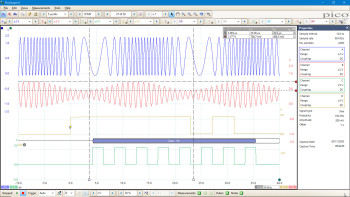
Up to 8 channels of high resolution
With the PicoScope 4000A Series providing a choice of either 2, 4 or 8 high-resolution analog channels you can easily view audio, ultrasonic, vibration and power waveforms, analyze timing of complex systems, and perform a wide range of precision measurement tasks on multiple inputs at the same time. The scopes have a small, compact footprint, yet the BNC connectors with a minimum 20 mm spacing still accept all common probes and accessories. Despite their compact size, there is no compromise on performance. With a high vertical resolution of 12 bits, 20 MHz bandwidth, 256 MS buffer memory, and a fast sampling rate of 80 MS/s, the PicoScope 4000A Series has the power and functionality to deliver accurate results. With up to 8 channels, these oscilloscopes can analyze multiple serial buses such as UART, I2C, SPI, CAN and LIN plus control and driver signals.
Why choose the PicoScope 4000A Series oscilloscopes?
The PicoScope 4000A Series provides 20 MHz bandwidth, low noise, 12-bit resolution, deep capture memory and an integrated function and arbitrary waveform generator in a compact USB 3 connected PC-based package, together with a proven user interface. This series of oscilloscopes is especially suited to engineers, scientists and technicians working on a wide range of electrical, mechanical, audio, lidar, radar, ultrasonic, NDT and predictive maintenance systems who need to make precise measurements and analysis of repetitive or single-shot long-duration waveforms.
The PicoScope 4000A Series is unlike conventional oscilloscopes with 8-bit resolution and limited capture memory or card-based digitizers that require an expensive mainframe and offers the following benefits:
- PicoScope 6 user interface with time- and frequency-domain waveform views
- Automatic measurements of important waveform parameters on up to a million waveform cycles with each triggered acquisition using DeepMeasure™
- Decoding of 18 popular industry serial bus standards
- An application programming interface that provides direct control of the hardware
- Five-year warranty included as standard
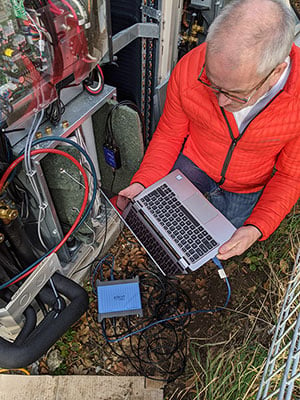 Suitable for a broad range of applications, including:
Suitable for a broad range of applications, including:
- Power supply start sequencing
- 7-channel audio systems
- Multi-sensor systems
- Multi-phase drives and controls
- Predictive/preventive maintenance
- Complex embedded system development
- Power harmonics analysis
- Vibration analysis and diagnostics
- Long-duration waveform capture
- Lubricant analysis
- Acoustic emission analysis
- Oil condition sensors
- Machine monitoring
- Motor condition monitoring overview and motor current signature analysis (MCSA)
- Model-based voltage and current systems
- Infrared thermography
Complex embedded systems
When debugging an embedded system with a scope, you can quickly run out of channels. You may need to look at an I2C or SPI bus at the same time as multiple power rails, DAC outputs and logic signals. With up to eight channels, the PicoScope 4000A Series can cope with all of this. Choose whether to decode up to eight serial buses, with analog waveforms and decoded data both visible, or a combination of serial buses and other analog or digital signals. PicoScope provides advanced triggering on all channels, so you can search for runt pulses, dropouts and noise as well as looking for data patterns using the 4-input Boolean logic trigger.
PicoScope 4000A Series features
Digital triggering
Most digital oscilloscopes still use an analog trigger architecture based on comparators. This can cause time and amplitude errors that cannot always be calibrated out. The use of comparators often limits the trigger sensitivity at high bandwidths and can also create a long trigger rearm delay.
In 1991 Pico set an innovation milestone by pioneering the use of full digital triggering using the actual digitized data. This reduces trigger errors and allows our oscilloscopes to trigger on the smallest signals, even at the full bandwidth. All real-time triggering is digital, resulting in high threshold resolution with programmable hysteresis and optimal waveform stability.
The reduced rearm delay provided by digital triggering, together with segmented memory, allows the capture of events that happen in rapid sequence. At the fastest timebase, rapid triggering can capture a new waveform every 3 microseconds until the buffer is full.
Advanced triggers
As well as the standard range of triggers found on most oscilloscopes, the PicoScope 4000A Series has a comprehensive set of advanced triggers built in to help you capture the data you need. These include pulse width, windowed, and dropout triggers to help you find and capture your signal quickly.
DeepMeasure™
One waveform, millions of measurements.
Measurement of waveform pulses and cycles is key to verification of the performance of electrical and electronic devices.
DeepMeasure delivers automatic measurements of important waveform parameters, such as pulse width, rise time and voltage. Up to a million cycles can be displayed with each triggered acquisition. Results can be easily sorted, analyzed and correlated with the waveform display.
100 000 waveforms per second
An important specification to understand when evaluating oscilloscope performance is the waveform update rate, which is expressed as waveforms per second. While the sample rate indicates how frequently the oscilloscope samples the input signal within one waveform, or cycle, the waveform capture rate refers to how quickly an oscilloscope acquires waveforms.
Oscilloscopes with high waveform capture rates provide better visual insight into signal behavior and dramatically increase the probability that the oscilloscope will quickly capture transient anomalies such as jitter, runt pulses and glitches – that you may not even know exist.
The PicoScope 4000A Series oscilloscopes use hardware acceleration to achieve up to 100 000 waveforms per second.
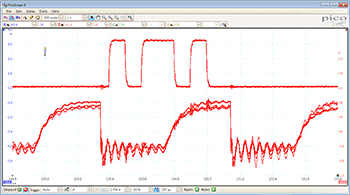
Arbitrary waveform and function generators
All models in the PicoScope 4000A Series have a built-in low-distortion, 80 MS/s, 14-bit arbitrary waveform generator (AWG), which can be used to emulate missing sensor signals during product development, or to stress-test a design over the full intended operating range. Waveforms can be imported from data files or created and modified using the built-in graphical AWG editor.
A function generator is also included, with sine, square, and triangle waves up to 1 MHz, along with DC level, white noise, and many more standard waveforms. As well as level, offset and frequency controls, advanced options allow you to sweep over a range of frequencies. Combined with the spectrum peak hold option, this creates a powerful tool for testing amplifier and filter responses.
Color persistence modes
Advanced display modes allow you to see old and new data superimposed, with new data in a brighter color or shade. This makes it easy to see glitches and dropouts and to estimate their relative frequency. Choose between analog persistence, digital color, or custom display modes.
High-end features as standard
Buying a PicoScope is not like making a purchase from other oscilloscope companies, where optional extras considerably increase the price. With our scopes, high-end features such as resolution enhancement, mask limit testing, serial decoding, advanced triggering, automatic measurements, math channels, XY mode, segmented memory, and a signal generator are all included in the price.
To protect your investment, both the PC software and firmware inside the scope can be updated. Pico Technology has a long history of providing new features for free through software downloads. We deliver on our promises of future enhancements year after year, unlike many other companies in the field. Users of our products reward us by becoming lifelong customers and frequently recommending us to their colleagues.
PicoScope performance and reliability
With over 30 years’ experience in the test and measurement industry, we know what’s important in an oscilloscope. The PicoScope 4000A Series delivers value for money by including a wide range of high-end features as standard. The PicoScope 6 software includes serial decoding and mask limit testing, and new functionality is regularly delivered through free upgrades to ensure that your device does not quickly become outdated. All Pico Technology devices are optimized with the help of feedback from our customers.
Zoom in and capture every last detail
The PicoScope zoom function lets you take a closer look at the fine detail on your signals. Using simple point-and-click tools you can quickly zoom in on both axes and reveal every last detail of the signal, whilst the undo zoom function lets you return to the previous view.
USB connectivity
The SuperSpeed USB 3.0 connection not only allows high-speed data acquisition and transfer, but also makes printing, copying, saving, and emailing your data from the field quick and easy. USB powering removes the need to carry around a bulky external power supply, making the kit even more portable for the engineer on the move.
The Software Development Kit (PicoSDK®) allows unlimited data collection and fast streaming.
Software for the PicoScope 4000A Series
Split-screen display
The PicoScope 6 software can display up to 16 scope and spectrum views at once, making comparisons and analysis even clearer. The split-screen display can be customized to show whichever combination of waveforms you need, to display multiple channels or different variants of the same signal. Additionally, each waveform shown works with individual zoom, pan, and filter settings for ultimate flexibility. Alongside the facility to use monitors many times larger than a fixed scope display, these are further reasons to choose a USB oscilloscope over a traditional benchtop model.
Power measurements
The PicoScope 4000A Series is ideal for making a range of power measurements on high voltages and currents and low-voltage control signals. For the best results, use a Pico differential voltage probe (TA041 or TA057) in combination with a current clamp (TA167) or probes (TA167, TA325 or TA326). To improve the efficiency and reliability of power designs, the scope can display and analyze standby power dissipation, inrush current, and steady-state power consumption. PicoScope’s built-in measurements and statistics of parameters such as true RMS, frequency, peak‑to-peak voltage and THD allow accurate analysis of power quality.
Nonlinear loads and modern power-conversion equipment produce complex waveforms with significant harmonic content. These harmonics reduce efficiency by causing increased heating in equipment and conductors, misfiring in variable speed drives, and torque pulsations in motors. The 12-bit PicoScope 4000A Series has the precision to measure distortion typically up to the 100th harmonic. On the supply side, power quality issues such as sags and dips, swells and spikes, flicker, interruptions and long-term voltage and frequency variations can also be checked for regulatory compliance.
In a 3-phase distribution system, it is important to characterize and balance loads across phases. With up to 8 channels, the PicoScope 4000A Series can monitor waveforms of current and voltage on all 4 conductors of a 3-phase-plus‑neutral system. This helps to identify mismatches that can cause breaker tripping, or transformer and conductor overheating.
Math channels
With PicoScope 6 you can perform a variety of mathematical calculations on your input signals and reference waveforms.
Use the built-in list for simple functions such as addition and inversion, or open the equation editor and create complex functions involving trigonometry, exponentials, logarithms, statistics, integrals and derivatives, filters, averaging and peak-detection.
Spectrum analyzer
With the click of a button, you can open a new window to display a spectrum plot of selected channels up to the full bandwidth of the oscilloscope. A comprehensive range of settings gives you control over the number of spectrum bands, window types and display modes.
A comprehensive set of automatic frequency-domain measurements can be added to the display, including THD, THD+N, SINAD, SNR, SFDR and IMD. You can even use the AWG and spectrum mode together to perform swept scalar network analysis, and you can apply mask testing to the spectrum display to speed up fault-finding.
Automatic measurements
PicoScope allows you to display a table of automated measurements for troubleshooting and analysis: 15 scope and 11 spectrum mode measurements are available.

Using the built-in measurement statistics you can see the average, standard deviation, maximum and minimum of each measurement as well as the live value. You can add as many measurements as you need on each view. Each measurement includes statistical parameters showing its variability. For information on the measurements available in scope and spectrum modes, see Automatic Measurements in the Specifications table.

Serial decoding
The PicoScope 4000A Series includes serial decoding capability across all channels as standard. PicoScope software can decode 1-Wire, ARINC 429, CAN, DALI, DCC, DMX512, Ethernet 10Base-T, FlexRay, I²C, I²S, LIN, Manchester, Modbus ASCII, Modbus RTU, PS/2, SENT, SPI, and UART protocol data as standard, with more protocols in development and available in the future with free-of-charge software upgrades.
The decoded data can be displayed in the format of your choice: in graph, in table, or both at once.
- Graph format shows the decoded data beneath the waveform on a common time axis, with error frames marked in red. These frames can be zoomed to investigate noise or distortion.
- Table format shows a list of the decoded frames, including the data and all flags and identifiers. You can set up filtering conditions to display only the frames you are interested in, search for frames with specified properties, or define a start pattern to signal when the program should list the data.
PicoScope can also import a spreadsheet to decode the hexadecimal data into user-defined text strings.
Mask limit testing
PicoScope allows you to draw a mask around any signal, in either the scope view or the spectrum view, with user-defined tolerances. This has been designed specifically for production and debugging environments, enabling you to compare signals. Simply capture a known good signal, draw a mask around it, and then attach the system under test. PicoScope will capture any intermittent glitches and can show a failure count and other statistics in the Measurements window.
The numerical and graphical mask editors can be used separately or in combination, allowing you to enter accurate mask specifications, modify existing masks, and import and export masks as files.
Alarms
PicoScope can be programmed to execute actions when certain events occur. The events that can trigger an alarm include mask limit fails, trigger events and buffers full. The actions that PicoScope can execute include saving a file, playing a sound, executing a program and triggering the signal generator or the AWG. Alarms, coupled with mask limit testing, help create a powerful and time-saving waveform monitoring tool. Capture a known good signal, auto-generate a mask around it and then use the alarms to automatically save any waveform (complete with a time/date stamp) that does not meet specification.
Digital low-pass filtering
Each input channel has its own digital low-pass filter with independently adjustable cut-off frequency from 1 Hz to the full bandwidth of the scope. This enables you to reject noise on selected channels while viewing high‑bandwidth signals on the others.
Custom probe settings
The custom probes menu allows you to correct for gain, attenuation, offsets and nonlinearities of probes and transducers, or convert to different measurement units. Definitions for standard Pico-supplied probes are built in, and you can also create your own using linear scaling or even an interpolated data table, and save them to disk for later use.
PicoSDK – write your own apps
Our free software development kit, PicoSDK, allows you to write your own software and includes drivers for Windows, macOS and Linux. Example code supplied on our GitHub
organization page shows how to interface to third-party software packages such as National Instruments LabVIEW and MathWorks MATLAB.
PicoSDK supports data streaming, a mode that captures gap-free continuous data over USB 3.0 direct to the PC’s RAM or hard disk, at a rate of up to 80 MS/s on one channel (up to 160 MS/s split between multiple channels), so you are not limited by the size of the scope’s buffer memory. Sampling rates in streaming mode are subject to PC specifications and application loading.
There is also an active community of PicoScope users who share both code and whole applications on our Test and Measurement Forum and the PicoApps section of the website. The Frequency Response Analyzer shown here is a popular application on the forum.
PicoLog 6 software
The PicoScope 4000A Series oscilloscopes are also supported by the PicoLog 6 data logging software, allowing you to view and record signals on multiple units in one capture.
PicoLog 6 allows sample rates of up to 1 kS/s per channel, and is ideal for long-term observation of general parameters, such as voltage or current levels, on several channels at the same time, whereas the PicoScope 6 software is more suitable for waveshape or harmonic analysis.
You can also use PicoLog 6 to view data from your oscilloscope alongside a data logger or other device. For example, you could measure voltage and current with your PicoScope and plot both against temperature using a TC-08 thermocouple data logger, or humidity with a DrDAQ multipurpose data logger.
PicoLog 6 is available for Windows, macOS, Linux and Raspberry Pi OS.
PicoScope 4824A specifications
| Oscilloscope – vertical | |
| Input channels | 8 |
| Bandwidth (−3 dB) | 20 MHz (50 mV to 50 V ranges) 10 MHz (10 mV and 20 mV ranges) |
| Rise time (calculated) | 17.5 ns (50 mV to 50 V ranges) 35.0 ns (10 mV and 20 mV ranges) |
| Input type | BNC, at least 20 mm spacing |
| Vertical resolution | 12 bits |
| Software-enhanced vertical resolution | Up to 16 bits |
| Input sensitivity | 2 mV/div to 10 V/div (10 vertical divisions) |
| Input ranges | ±10 mV to ±50 V full scale, in 12 ranges |
| Input coupling | Software-selectable AC / DC |
| Input characteristics | 1 MΩ ∥ 19 pF |
| DC accuracy | ±1% of full scale ±300 μV |
| Analog offset range (vertical position adjustment) | ±250 mV (10 mV to 500 mV ranges) ±2.5 V (1 V to 5 V ranges) ±25 V (10 V to 50 V ranges) |
| Analog offset accuracy | ±1% of offset setting additional to basic DC accuracy |
| Maximum input voltage | ±50 V DC, 42.4 V peak AC |
| Overvoltage protection | ±100 V (DC + AC peak) |
| Oscilloscope – horizontal | |
| Maximum sampling rate (real-time) | 80 MS/s (up to four channels in use) 40 MS/s (five or more channels in use) |
| Maximum sampling rate (USB 3.0, continuous streaming mode) | 20 MS/s using PicoScope 6 software, shared between channels 80 MS/s max. for a single channel using PicoSDK. 160 MS/s total across all channels. (PC-dependent) |
| Timebase ranges | 20 ns/div to 5000 s/div |
| Buffer memory | 256 MS shared between active channels |
| Streaming buffer memory (PicoScope) | 100 MS |
| Streaming buffer memory (SDK) | Up to available PC memory |
| Maximum buffer segments | 10,000 |
| Maximum waveforms per second | 100,000 (PC-dependent) |
| Timebase accuracy | ±20 ppm (+5 ppm/year) |
| Sample jitter | 25 ps RMS typical |
| Dynamic performance (typical) | |
| Crosstalk | −76 dB, DC to 20 MHz |
| Harmonic distortion | < −60 dB, 10 mV range < −70 dB, 20 mV and higher ranges |
| SFDR | > 60 dB, 20 mV and 10 mV ranges > 70 dB, 50 mV and higher ranges |
| Noise | 45 μV RMS on 10 mV range |
| Bandwidth flatness | DC to full bandwidth (+0.2 dB, −3 dB) |
| Pulse response | < 1% overshoot |
| Triggering | |
| Source | Channels A to H |
| Trigger modes | Free run, auto, repeat, single, rapid (segmented memory) |
| Trigger types | Edge with adjustable hysteresis, pulse width, window, window pulse width, dropout, window dropout, interval, logic level, runt pulse |
| Trigger sensitivity | Digital triggering provides 1 LSB accuracy up to full bandwidth |
| Maximum pre-trigger capture | 100% of capture size |
| Maximum post-trigger delay | Zero to 4 billion samples (settable in 1 sample steps) |
| Trigger rearm time | < 3 μs on fastest timebase |
| Maximum trigger rate | Up to 10 000 waveforms in a 30 ms burst |
| Advanced digital trigger levels | All trigger levels, window levels and hysteresis values settable with 1 LSB resolution across input range |
| Advanced digital time intervals | Settable with 1 sample resolution from 1 sample (minimum 12.5 ns) up to 4 billion sample intervals |
| Function generator | |
| Standard output signals | Sine, square, triangle, DC voltage, ramp, sinc, Gaussian, half-sine, white noise, PRBS |
| Standard signal frequency | 0.03 Hz to 1 MHz |
| Sweep modes | Up, down, dual |
| Triggering | Can trigger a counted number of waveform cycles or sweeps (up to 1 billion) from the scope trigger or manually from software. |
| Frequency accuracy | ±20 ppm |
| Frequency resolution | < 0.02 Hz |
| Voltage range | ±2 V |
| Amplitude and offset adjustment | Signal amplitude and offset within ± 2V range. Adjustable in approx 300 μV steps. |
| Amplitude flatness | < 0.5 dB to 1 MHz typical |
| DC accuracy | ±1% of full scale |
| SFDR | 87 dB typical |
| Output characteristics | Rear-panel BNC, 600 Ω output impedance |
| Overvoltage protection | ±10 V |
| Arbitrary waveform generator | |
| Update rate | 80 MS/s |
| Buffer size | 16 kS |
| Resolution | 14 bits (output step size approximately 300 μV) |
| Bandwidth | 1 MHz |
| Rise time (10% to 90%) | 150 ns |
| Sweep modes, triggering, frequency accuracy and resolution, voltage range and accuracy and output characteristics as for function generator. | |
| Spectrum analyzer | |||||
| Frequency range | DC to 20 MHz | ||||
| Display modes | Magnitude, average, peak hold | ||||
| Windowing functions | Rectangular, Gaussian, triangular, Blackman, Blackman-Harris, Hamming, Hann, flat-top | ||||
| Number of FFT points | Selectable from 128 up to 1 million in powers of 2 | ||||
| Scale / units | X axis : linear or log 10 Y axis : logarithmic (dbV, dBu, dBm, arbitrary) or linear (volts) | ||||
| Math channels | |
| General functions | −x, x+y, x−y, x*y, x/y, x^y, sqrt, exp, ln, log, abs, norm, sign, sin, cos, tan, arcsin, arccos, arctan, sinh, cosh, tanh, derivative, integral, delay |
| Filter functions | Lowpass, highpass, bandstop, bandpass |
| Graphing functions | Frequency, duty cycle |
| Multi-waveform functions | Min, max, average, peak |
| Operands | Input channels, reference waveforms, time, constants, pi |
| Automatic measurements | |
| Scope mode | AC RMS, true RMS, cycle time, DC average, duty cycle, falling rate, fall time, frequency, high pulse width, low pulse width, maximum, minimum, peak to peak, rise time, rising rate. |
| Spectrum mode | Frequency at peak, amplitude at peak, average amplitude at peak, total power, THD %, THD dB, THD+N, SFDR, SINAD, SNR, IMD |
| Statistics | Minimum, maximum, average and standard deviation |
| DeepMeasure™ | |
| Scope mode | AC RMS, true RMS, cycle time, DC average, duty cycle, falling rate, fall time, frequency, high pulse width, low pulse width, maximum, minimum, peak to peak, rise time, rising rate. |
| Spectrum mode | Frequency at peak, amplitude at peak, average amplitude at peak, total power, THD %, THD dB, THD+N, SFDR, SINAD, SNR, IMD |
| Statistics | Minimum, maximum, average and standard deviation |
| Serial decoding | |
| Protocols | 1-Wire, ARINC 429, CAN, CAN FD, CAN J1939, DALI, DCC, DMX512, Ethernet (10Base-T), FlexRay, I²C, I²S, LIN, Manchester, MODBUS (ASCII and RTU), PS/2, SENT, SPI, UART/RS-232. Subject to number of channels available. |
| Inputs | All input channels with any mixture of protocols |
| Mask limit testing | |
| Mask creation | User-drawn, table entry, auto-generated from waveform or imported from file |
| Actions | Highlight on screen, select in buffer overview, activate alarm |
| Statistics | Pass/fail, failure count, total count |
| Alarms | |
| Initiating events | Capture, buffer full, mask fail |
| Alarm actions | Beep, play sound, stop/restart capture, run executable, save current buffer/all buffers, trigger signal generator |
| Display | |
| Interpolation | Linear or sin(x)/x |
| Persistence modes | Digital color, analog intensity, fast, custom |
| Data export | |
| Output file formats | BMP, CSV, GIF, JPG, MATLAB 4, PDF, PNG, PicoScope data, PicoScope settings, TXT |
| Output functions | Copy to clipboard, print |
| Environmental | |
| Temperature range (operating) | 0 °C to 45 °C |
| Temperature range (stated accuracy) | 20 °C to 30 °C |
| Temperature range (storage) | –20 °C to +60 °C |
| Humidity range (operating) | 5% to 80% RH non-condensing |
| Humidity range (storage) | 5% to 95% RH non-condensing |
| Altitude | Up to 2000 m |
| Pollution degree | EN 61010 pollution degree 2: “only nonconductive pollution occurs except that occasionally a temporary conductivity caused by condensation is expected” |
| Physical properties | |
| Dimensions | 190 x 170 x 40 mm (7.5″ x 6.7″ x 1.6″) |
| Weight | < 0.55 kg (19.4 oz) |
| Software | |
| Windows software | PicoScope 6 PicoLog 6 PicoSDK software development kit Windows 7, 8 or 10 recommended (read more) |
| macOS software | PicoScope 6 Beta PicoLog 6 Software development kit (SDK) OS versions: see release notes |
| Linux software | PicoScope 6 Beta Software development kit (SDK) See Linux Software & Drivers for details of supported distributions |
| Raspberry Pi software | PicoLog 6 for Raspberry Pi 3B and 4B (Raspberry Pi OS) |
| Languages | PicoScope 6: English, Chinese (simplified), Chinese (traditional), Czech, Danish, Dutch, Finnish, French, German, Greek, Hungarian, Italian, Japanese, Korean, Norwegian, Polish, Portuguese, Romanian, Russian, Spanish, Swedish, Turkish PicoLog 6: English (UK), English (US), Simplified Chinese, Dutch, French, German, Italian, Japanese, Korean, Russian, Spanish |
| General | ||
| What’s in the box? | PicoScope 4000A Series high-resolution oscilloscope USB 3.0 cable USB Oscilloscope Quick Start Guide 10:1/1:1 switched probes (quantity shown below) | |
| Number of probes included | 4 | |
| PC connectivity | SuperSpeed USB 3.0 (USB 2.0 compatible) | |
| Power requirements | Powered from USB | |
| Ground terminal | M4 screw on rear panel | |
PicoScope 4000 documents
PicoScope 4000A Series Data Sheet
PicoScope 4000 Series User’s Guide
PicoScope 4000 Series (A API) Programmer’s Guide
PicoScope USB Oscilloscope Quick Start Guide
Pack contents
- PicoScope 4824A 8-channel oscilloscope
- 4x Oscilloscope probes
- USB 3.0 cable 1.8 m
- Quick Start Guide


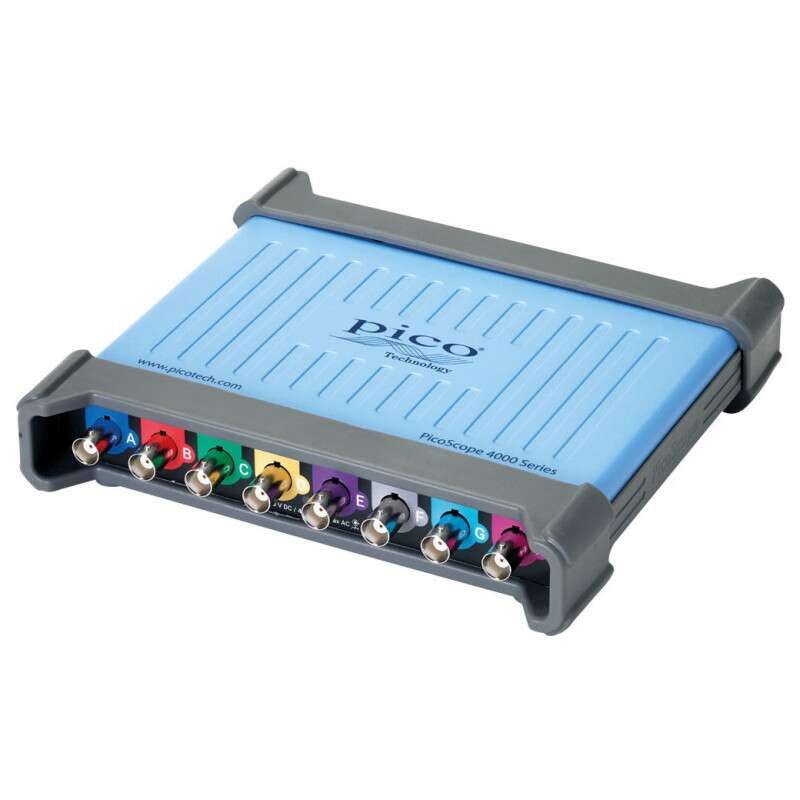
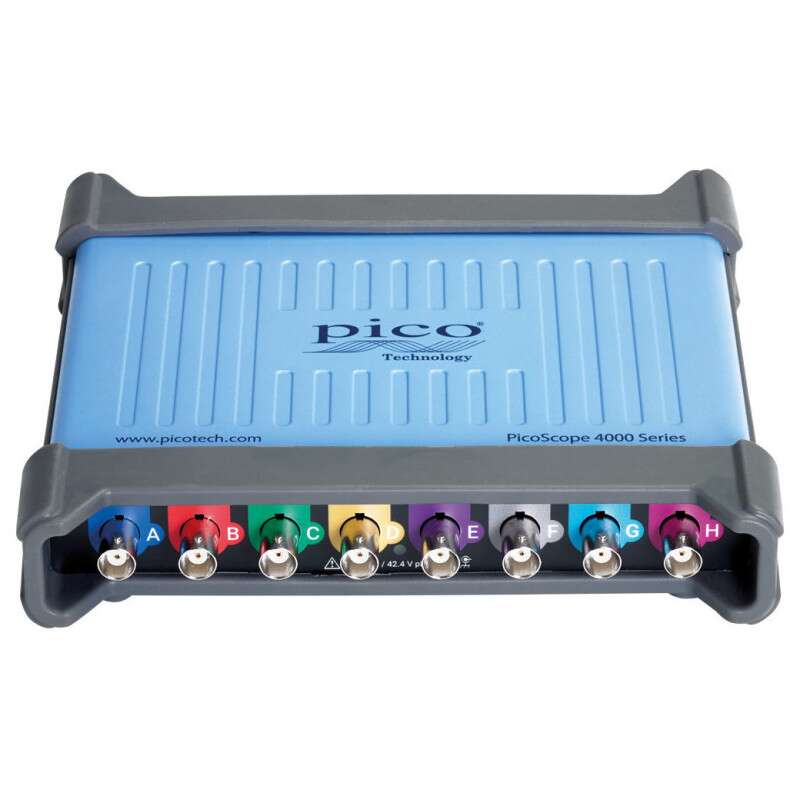
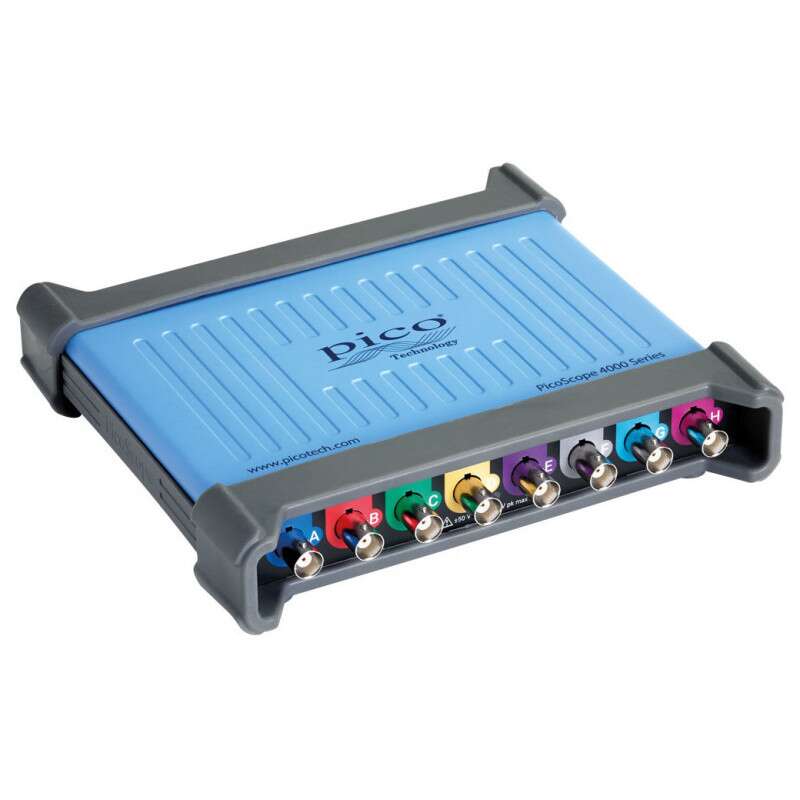
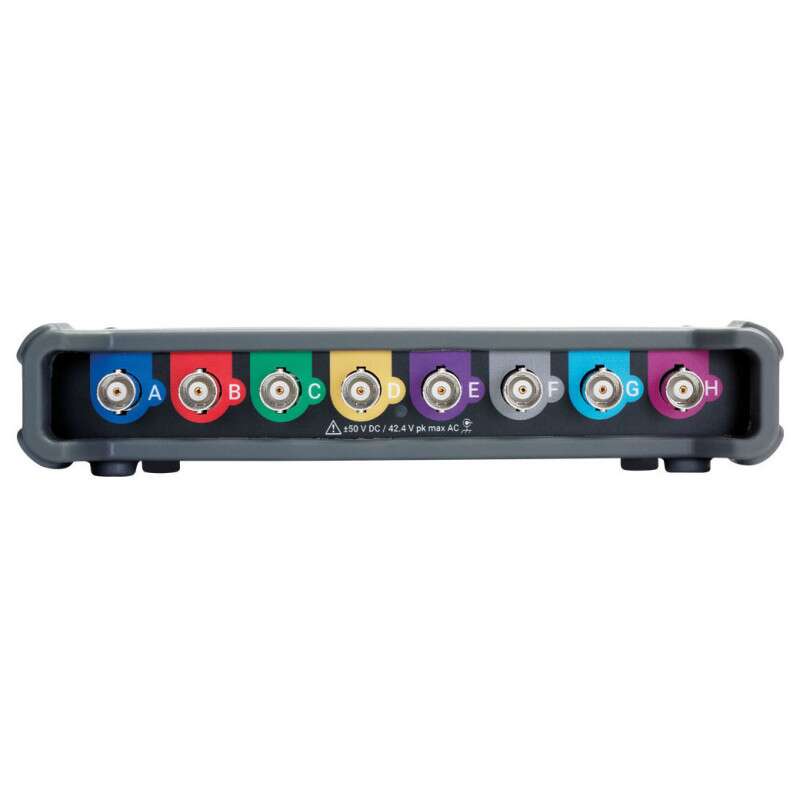
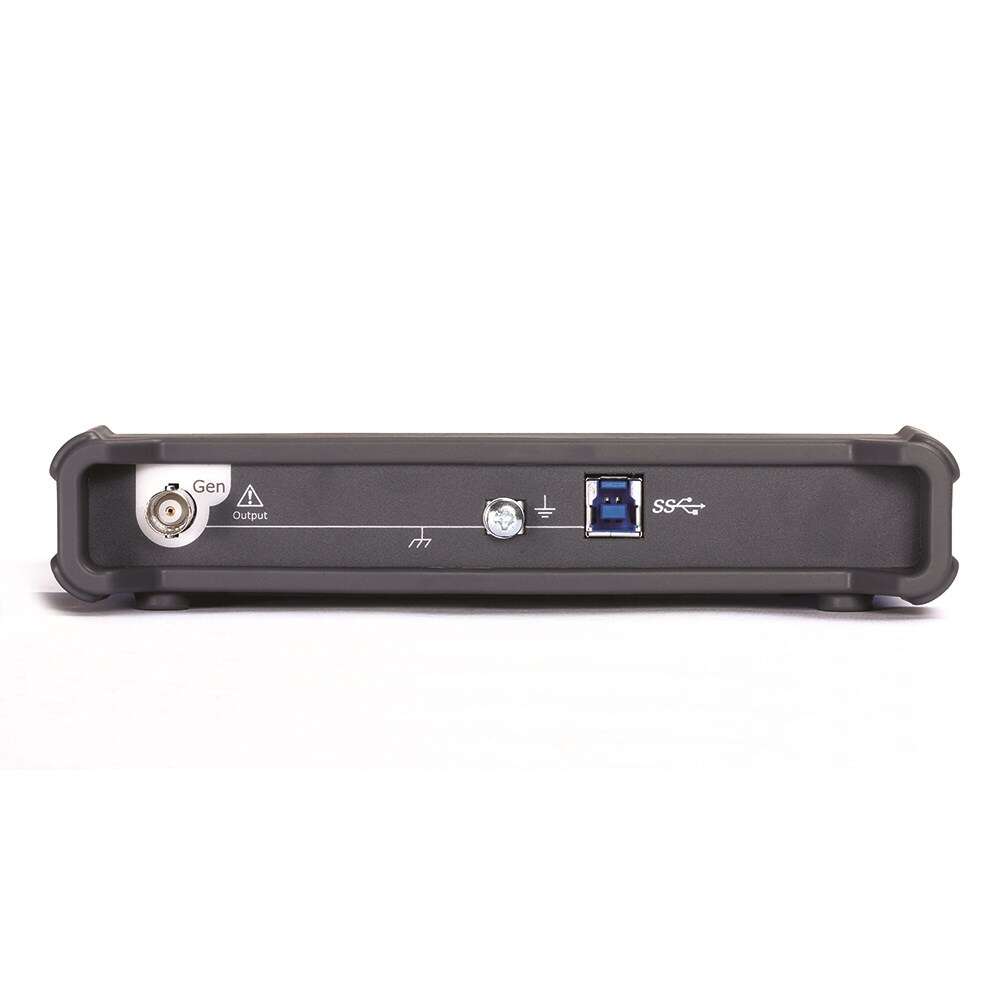
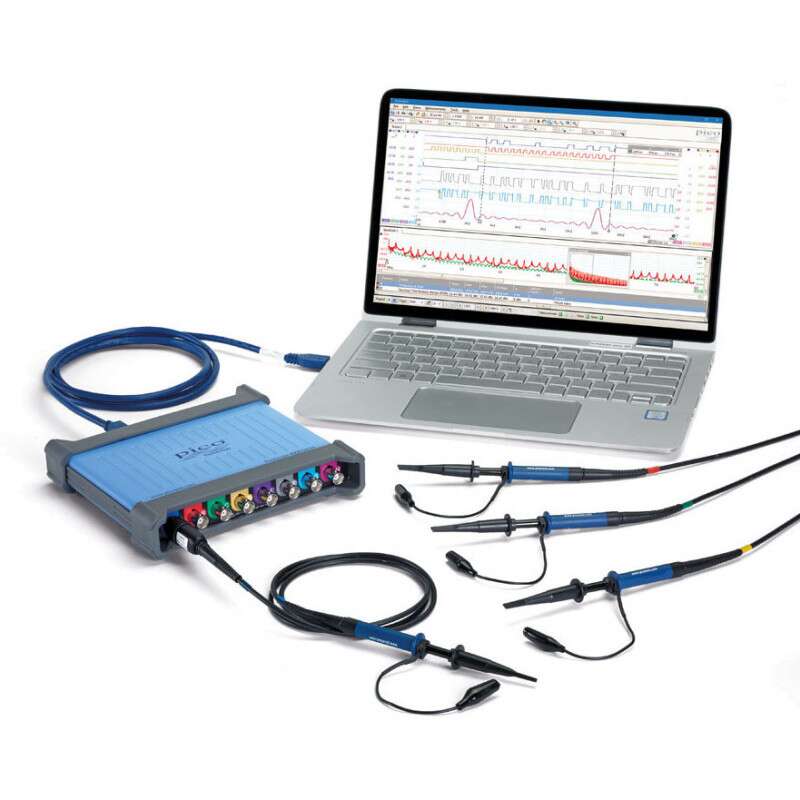

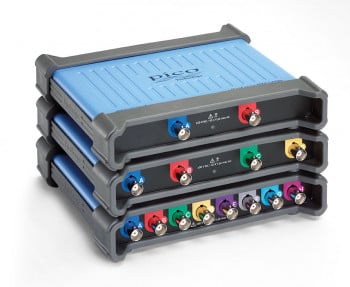
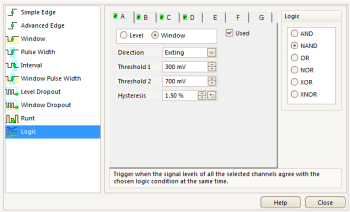



















Reviews
There are no reviews yet.